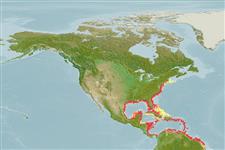>
Cyprinodontiformes (Rivulines, killifishes and live bearers) >
Cyprinodontidae (Pupfishes) > Cyprinodontinae
Etymology: Cyprinodon: Latin, cyprinus = carp + Greek, odous = teeth (Ref. 45335); variegatus: From the words Cyprinus=a genus of minnows and odious (stem odont)=tooth, meaning minnows with teeth; variegates Latin for variegated, variously colored (Ref. 79012).
More on author: Lacepède.
Environment: milieu / climate zone / depth range / distribution range
Ecologia
marinhas; Água doce; estuarina bentopelágico; não migratória. Subtropical; 45°N - 0°N, 98°W - 49°W
North and South America: Massachusetts, USA to northeastern Mexico; and West Indies (Ref. 86798); northern coast of South America (Ref. 5217).
Tamanho / Peso / Idade
Maturity: Lm ? range ? - ? cm
Max length : 9.0 cm TL macho/indeterminado; (Ref. 27139); common length : 3.0 cm TL macho/indeterminado; (Ref. 5217)
A short, deep-bodied, compressed fish. Scales large, dorsal profile straight from tip of snout to front of dorsal fin; dark marginal band on tail (Ref. 26938).
Occurs usually near vegetation in salt, brackish and fresh water (Ref. 86798). Inhabits hypersaline lagoons and connecting channels. Found on muddy bottoms in turbid waters (Ref. 5217). Omnivorous; consuming organic detritus and algae, as well as microcrustaceans, and dipteran larvae (Ref. 79012). Caught with fine-meshed nets. Very abundant and easily reproduced in captivity. Used as a forage fish in mariculture (Ref. 5217). Not a seasonal killifish. Is easy to maintain in the aquarium (Ref. 27139).
Ciclo de vida ou comportamento de acasalamento
Maturities | Reprodução | Spawnings | Egg(s) | Fecundities | Larvas
Page, L.M. and B.M. Burr, 2011. A field guide to freshwater fishes of North America north of Mexico. Boston : Houghton Mifflin Harcourt, 663p. (Ref. 86798)
Status na Lista Vermelha da UICN (Ref. 130435)
Ameaça para os humanos
Harmless
Uso pelos humanos
Pescarias: espécies comerciais; Aquário: Espécies comerciais; isca: usually
Ferramentas
Relatórios especiais
Baixar XML
Fontes da internet
Estimates based on models
Preferred temperature (Ref.
123201): 15.4 - 27.7, mean 26.7 °C (based on 572 cells).
Índice de diversidade filogenética (Ref.
82804): PD
50 = 0.5000 [Uniqueness, from 0.5 = low to 2.0 = high].
Bayesian length-weight: a=0.02188 (0.00833 - 0.05747), b=3.06 (2.83 - 3.29), in cm total length, based on LWR estimates for this (Sub)family-body shape (Ref.
93245).
Nível Trófico (Ref.
69278): 2.4 ±0.1 se; based on size and trophs of closest relatives
Resiliência (Ref.
120179): médio(a), tempo mínimo de duplicação da população 1,4 - 4,4 anos (Assuming tm<1 and Fec<1000).
Fishing Vulnerability (Ref.
59153): Low vulnerability (10 of 100).
Nutrients (Ref.
124155): Calcium = 200 [104, 445] mg/100g; Iron = 1.36 [0.70, 2.71] mg/100g; Protein = 17 [16, 18] %; Omega3 = 0.251 [0.113, 0.552] g/100g; Selenium = 10.3 [4.6, 25.5] μg/100g; VitaminA = 21.2 [5.7, 77.3] μg/100g; Zinc = 1.99 [1.28, 3.21] mg/100g (wet weight);
